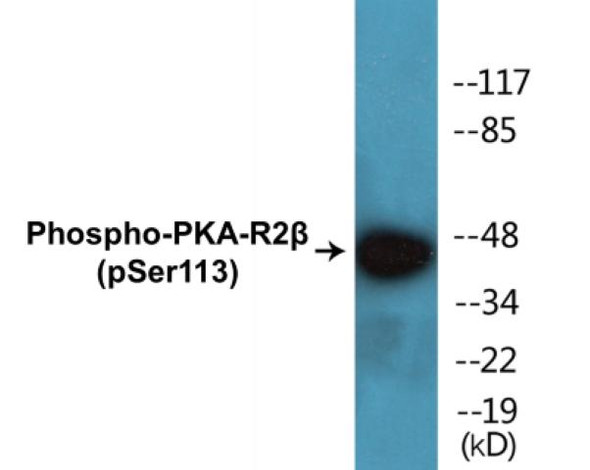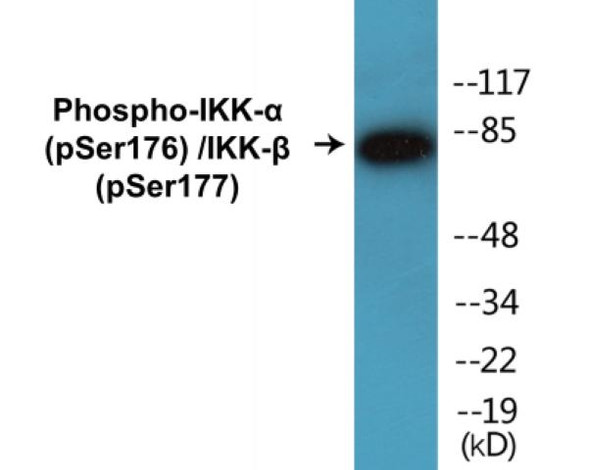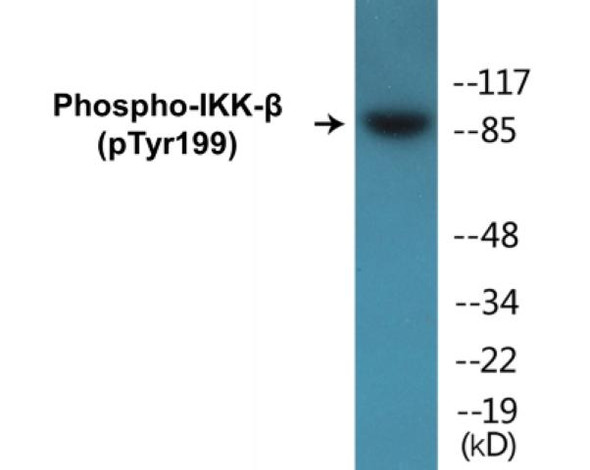PKA alpha/beta CAT (Phospho-Thr197) Colorimetric Cell-Based ELISA Kit
- SKU:
- CBCAB00098
- Product Type:
- ELISA Kit
- ELISA Type:
- Cell Based Phospho Specific
- Reactivity:
- Human
- Mouse
- Rat
- Detection Method:
- Colorimetric
Description
PKA alpha/beta CAT (Phospho-Thr197)Colorimetric Cell-Based ELISA Kit
The PKA Alpha/Beta Cat Phospho-Thr197 Colorimetric Cell-Based ELISA Kit is a cutting-edge research tool designed for the accurate and precise detection of phosphorylated PKA alpha/beta catenin at threonine 197 in cell lysates and tissue samples. This kit features superior sensitivity and specificity, allowing for reliable and reproducible results in a variety of experimental settings.Phosphorylation of PKA alpha/beta catenin at threonine 197 is a crucial post-translational modification that regulates the activity of this key signaling protein. Dysregulation of PKA alpha/beta catenin phosphorylation has been implicated in a wide range of diseases, including cancer, neurological disorders, and metabolic conditions.
By targeting this specific phosphorylation site, researchers can gain valuable insights into the role of PKA alpha/beta catenin in these diseases and potentially identify new therapeutic targets.Overall, the PKA Alpha/Beta Cat Phospho-Thr197 Colorimetric Cell-Based ELISA Kit is an essential tool for researchers studying cell signaling pathways, protein phosphorylation, and disease mechanisms. With its high performance and ease of use, this kit is ideal for a wide range of laboratory applications and offers valuable information for advancing scientific knowledge and drug development efforts.
| Product Name: | PKA alpha/beta CAT (Phospho-Thr197) Colorimetric Cell-Based ELISA |
| Product Code: | CBCAB00098 |
| ELISA Type: | Cell-Based |
| Target: | PKA alpha/beta CAT (Phospho-Thr197) |
| Reactivity: | Human, Mouse, Rat |
| Dynamic Range: | > 5000 Cells |
| Detection Method: | Colorimetric 450 nm |
| Format: | 2 x 96-Well Microplates |
The PKA alpha/beta CAT (Phospho-Thr197) Colorimetric Cell-Based ELISA Kit is a convenient, lysate-free, high throughput and sensitive assay kit that can detect PKA alpha/beta CAT protein phosphorylation and expression profile in cells. The kit can be used for measuring the relative amounts of phosphorylated PKA alpha/beta CAT in cultured cells as well as screening for the effects that various treatments, inhibitors (ie. siRNA or chemicals), or activators have on PKA alpha/beta CAT phosphorylation.
Qualitative determination of PKA alpha/beta CAT (Phospho-Thr197) concentration is achieved by an indirect ELISA format. In essence, PKA alpha/beta CAT (Phospho-Thr197) is captured by PKA alpha/beta CAT (Phospho-Thr197)-specific primary antibodies while the HRP-conjugated secondary antibodies bind the Fc region of the primary antibody. Through this binding, the HRP enzyme conjugated to the secondary antibody can catalyze a colorimetric reaction upon substrate addition. Due to the qualitative nature of the Cell-Based ELISA, multiple normalization methods are needed:
| 1. | A monoclonal antibody specific for human GAPDH is included to serve as an internal positive control in normalizing the target absorbance values. |
| 2. | Following the colorimetric measurement of HRP activity via substrate addition, the Crystal Violet whole-cell staining method may be used to determine cell density. After staining, the results can be analysed by normalizing the absorbance values to cell amounts, by which the plating difference can be adjusted. |
| Database Information: | Gene ID: 5566/5567, UniProt ID: P17612/P22694/P22612, OMIM: 601639/176892, Unigene: Hs.631630/Hs.487325 |
| Gene Symbol: | PRKACA/PRKACB |
| Sub Type: | Phospho |
| UniProt Protein Function: | PKACA: catalytic subunit of cAMP-dependent protein kinase alpha, an AGC kinase. A number of inactive tetrameric holoenzymes are produced by the combination of homo- or heterodimers of the different regulatory subunits associated with two catalytic subunits. cAMP causes the dissociation of the inactive holoenzyme into a dimer of regulatory subunits bound to four cAMP and two free monomeric catalytic subunits. Two splice-variant isoforms have been described. |
| UniProt Protein Details: | Protein type:Protein kinase, AGC; Protein kinase, Ser/Thr (non-receptor); Kinase, protein; EC 2.7.11.11; AGC group; PKA family Chromosomal Location of Human Ortholog: 19p13.1 Cellular Component: centrosome; membrane; mitochondrion; plasma membrane; cytosol; nucleus; neuromuscular junction; AMP-activated protein kinase complex; cAMP-dependent protein kinase complex Molecular Function:protein binding; cAMP-dependent protein kinase activity; ubiquitin protein ligase binding; protein serine/threonine/tyrosine kinase activity; protein kinase binding; ATP binding Biological Process: nerve growth factor receptor signaling pathway; protein amino acid autophosphorylation; water transport; pathogenesis; signal transduction; protein amino acid phosphorylation; positive regulation of protein export from nucleus; triacylglycerol catabolic process; G2/M transition of mitotic cell cycle; transmembrane transport; sperm capacitation; regulation of synaptic transmission; epidermal growth factor receptor signaling pathway; fibroblast growth factor receptor signaling pathway; cytosolic calcium ion homeostasis; regulation of osteoblast differentiation; regulation of heart rate; organelle organization and biogenesis; activation of protein kinase A; peptidyl-threonine phosphorylation; glucose metabolic process; gluconeogenesis; peptidyl-serine phosphorylation; mesoderm formation; phospholipase C activation; regulation of protein binding; neural tube closure; carbohydrate metabolic process; energy reserve metabolic process; innate immune response; renal water homeostasis; mitotic cell cycle; blood coagulation; regulation of insulin secretion |
| NCBI Summary: | cAMP is a signaling molecule important for a variety of cellular functions. cAMP exerts its effects by activating the cAMP-dependent protein kinase, which transduces the signal through phosphorylation of different target proteins. The inactive kinase holoenzyme is a tetramer composed of two regulatory and two catalytic subunits. cAMP causes the dissociation of the inactive holoenzyme into a dimer of regulatory subunits bound to four cAMP and two free monomeric catalytic subunits. Four different regulatory subunits and three catalytic subunits have been identified in humans. The protein encoded by this gene is a member of the Ser/Thr protein kinase family and is a catalytic subunit of cAMP-dependent protein kinase. Alternatively spliced transcript variants encoding distinct isoforms have been observed. [provided by RefSeq, Jul 2008] |
| UniProt Code: | P17612 |
| NCBI GenInfo Identifier: | 125205 |
| NCBI Gene ID: | 5566 |
| NCBI Accession: | P17612.2 |
| UniProt Secondary Accession: | P17612,Q32P54, Q9H2Y0, Q9NRB4, Q9NRH9, |
| UniProt Related Accession: | P17612 |
| Molecular Weight: | 39,953 Da |
| NCBI Full Name: | cAMP-dependent protein kinase catalytic subunit alpha |
| NCBI Synonym Full Names: | protein kinase, cAMP-dependent, catalytic, alpha |
| NCBI Official Symbol: | PRKACA |
| NCBI Official Synonym Symbols: | PKACA |
| NCBI Protein Information: | cAMP-dependent protein kinase catalytic subunit alpha; PKA C-alpha; protein kinase A catalytic subunit; cAMP-dependent protein kinase catalytic subunit alpha, isoform 1 |
| UniProt Protein Name: | cAMP-dependent protein kinase catalytic subunit alpha |
| Protein Family: | cAMP-dependent protein kinase |
| UniProt Gene Name: | PRKACA |
| UniProt Entry Name: | KAPCA_HUMAN |
| Component | Quantity |
| 96-Well Cell Culture Clear-Bottom Microplate | 2 plates |
| 10X TBS | 24 mL |
| Quenching Buffer | 24 mL |
| Blocking Buffer | 50 mL |
| 15X Wash Buffer | 50 mL |
| Primary Antibody Diluent | 12 mL |
| 100x Anti-Phospho Target Antibody | 60 µL |
| 100x Anti-Target Antibody | 60 µL |
| Anti-GAPDH Antibody | 60 µL |
| HRP-Conjugated Anti-Rabbit IgG Antibody | 12 mL |
| HRP-Conjugated Anti-Mouse IgG Antibody | 12 mL |
| SDS Solution | 12 mL |
| Stop Solution | 24 mL |
| Ready-to-Use Substrate | 12 mL |
| Crystal Violet Solution | 12 mL |
| Adhesive Plate Seals | 2 seals |
The following materials and/or equipment are NOT provided in this kit but are necessary to successfully conduct the experiment:
- Microplate reader able to measure absorbance at 450 nm and/or 595 nm for Crystal Violet Cell Staining (Optional)
- Micropipettes with capability of measuring volumes ranging from 1 µL to 1 ml
- 37% formaldehyde (Sigma Cat# F-8775) or formaldehyde from other sources
- Squirt bottle, manifold dispenser, multichannel pipette reservoir or automated microplate washer
- Graph paper or computer software capable of generating or displaying logarithmic functions
- Absorbent papers or vacuum aspirator
- Test tubes or microfuge tubes capable of storing ≥1 ml
- Poly-L-Lysine (Sigma Cat# P4832 for suspension cells)
- Orbital shaker (optional)
- Deionized or sterile water
*Note: Protocols are specific to each batch/lot. For the correct instructions please follow the protocol included in your kit.
| Step | Procedure |
| 1. | Seed 200 µL of 20,000 adherent cells in culture medium in each well of a 96-well plate. The plates included in the kit are sterile and treated for cell culture. For suspension cells and loosely attached cells, coat the plates with 100 µL of 10 µg/ml Poly-L-Lysine (not included) to each well of a 96-well plate for 30 minutes at 37°C prior to adding cells. |
| 2. | Incubate the cells for overnight at 37°C, 5% CO2. |
| 3. | Treat the cells as desired. |
| 4. | Remove the cell culture medium and rinse with 200 µL of 1x TBS, twice. |
| 5. | Fix the cells by incubating with 100 µL of Fixing Solution for 20 minutes at room temperature. The 4% formaldehyde is used for adherent cells and 8% formaldehyde is used for suspension cells and loosely attached cells. |
| 6. | Remove the Fixing Solution and wash the plate 3 times with 200 µL 1x Wash Buffer for five minutes each time with gentle shaking on the orbital shaker. The plate can be stored at 4°C for a week. |
| 7. | Add 100 µL of Quenching Buffer and incubate for 20 minutes at room temperature. |
| 8. | Wash the plate 3 times with 1x Wash Buffer for 5 minutes each time. |
| 9. | Add 200 µL of Blocking Buffer and incubate for 1 hour at room temperature. |
| 10. | Wash 3 times with 200 µL of 1x Wash Buffer for 5 minutes each time. |
| 11. | Add 50 µL of 1x primary antibodies Anti-PKA alpha/beta CAT (Phospho-Thr197) Antibody, Anti-PKA alpha/beta CAT Antibody and/or Anti-GAPDH Antibody) to the corresponding wells, cover with Parafilm and incubate for 16 hours (overnight) at 4°C. If the target expression is known to be high, incubate for 2 hours at room temperature. |
| 12. | Wash 3 times with 200 µL of 1x Wash Buffer for 5 minutes each time. |
| 13. | Add 50 µL of 1x secondary antibodies (HRP-Conjugated AntiRabbit IgG Antibody or HRP-Conjugated Anti-Mouse IgG Antibody) to corresponding wells and incubate for 1.5 hours at room temperature. |
| 14. | Wash 3 times with 200 µL of 1x Wash Buffer for 5 minutes each time. |
| 15. | Add 50 µL of Ready-to-Use Substrate to each well and incubate for 30 minutes at room temperature in the dark. |
| 16. | Add 50 µL of Stop Solution to each well and read OD at 450 nm immediately using the microplate reader. |
(Additional Crystal Violet staining may be performed if desired – details of this may be found in the kit technical manual.)










